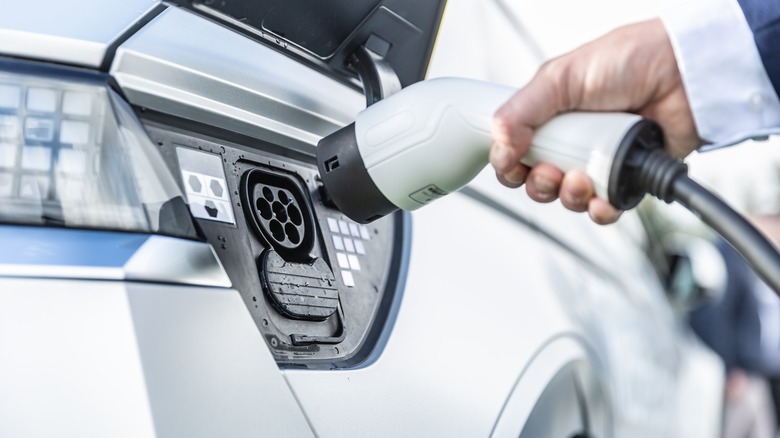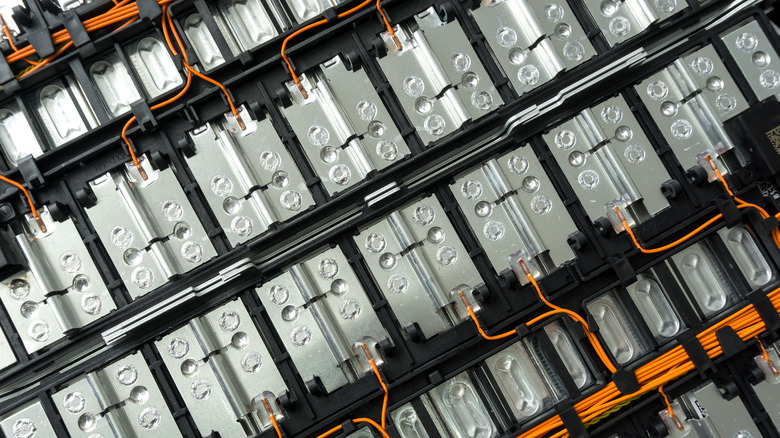7 Hidden Dangers Of Over Relying On Electric Vehicles
The automobile industry has come a long way since the sale of the first gas-powered vehicle in 1896. The industry boomed after Henry Ford introduced the Model T in 1908, and that same year, William Durant founded General Motors. Consumers and businesses alike coveted the practicality and convenience of cars. The automotive industry also played a particularly large role in supplying military vehicles for both World War I and II.
The popularity of automobiles did not fade, and by 1980, 87.2 percent of American households owned one or more cars. In modern times, we have a seemingly endless variety of vehicle options, including size, manufacturer, and even the power source these vehicles use.
Although it may seem like gas-powered vehicles were the only option for many decades, the U.S.'s first electric car came to fruition around 1890. Electric vehicles were for a time seen as the cleaner, easier-to-use automobile option. However, the improvement of roads outside of city limits and a sense of adventure played a significant role in the near-demise of the electric vehicle as they lacked the range and reliability of gas-powered cars.
In recent decades the electric car has been making a comeback in a big way, with some even calling to replace all gas-powered vehicles with electric ones. This may seem like a good idea. After all, they are the greener option so-to-speak, but is heavily relying on electric vehicles really the best option?
Lower range and longer charge times compared to gas
Cruising by other cars lined up at the gas pump in a fully electric vehicle can feel nice during your daily commute, depending on how long your drive is. However, electric cars typically have a lower range than their gas-powered counterparts, usually anywhere from 100 to 250 miles from a fully charged battery to empty. Some can go a bit further, like the Tesla Model S, which has an exceptional range of just over 400 miles before needing a charge.
For many drivers, this range suits their daily life perfectly fine. However, not everyone is a low-range driver, and if you need to recharge your EV, you may be waiting quite a bit longer than those at the pump. The standard 60 kWh battery in an electric vehicle takes about eight hours to go from empty to full charge. Even with a rapid charger, the range will only increase from zero to 100 miles in around 35 minutes, creating some lengthy wait times in comparison to a quick refuel.
Many electric car owners purchase them because they have a lifestyle that blends well with the car's functionality. However, some may be in for a rude awakening when they realize that while EV chargers are added more frequently in more locations, they're still far less convenient than a quick stop at the pump for a few hundred more miles.
Environmental exploitation for batteries
The battery is possibly the most important electrical aspect of an electric vehicle. Owners and admirers of electric-powered vehicles often take comfort in knowing that these cars run purely on battery power instead of gasoline, cutting out those unwanted fuel emissions. However, is the carbon footprint of the electric car battery really the better long-term option?
These batteries are lithium-ion, which is sourced from various parts of the globe. According to UNCTAD, half of it, though, comes from beneath the salt flats in the Andean regions of Argentina, Bolivia, and Chile. Mining lithium consumes a large amount of resources, especially water. It's estimated that almost two million liters of water are required for one ton of lithium. This water consumption leaves the region with soil contamination, environmental degradation, and local crop and livestock farmers in competition for the water they desperately need.
A crucial part of lithium-ion batteries is cobalt, and about half of the world's cobalt reserves can be found in the Democratic Republic of the Congo. Much of the cobalt is from artisanal mines where thousands of children are used for labor. The dangerous conditions of excavation dust can lead to a plethora of serious health conditions, including respiratory diseases and birth defects from the toxic metals, which include uranium, inhaled by the children.
Risk of fire and possible explosions
All cars are technically fire hazards, but one might think that electric vehicles are less of a fire hazard due to the absence of gasoline. However, the batteries inside electric cars are actually quite high-risk even without the addition of fuel. Lithium-ion batteries have been known to catch fire and, in some scary scenarios, even explode.
Lithium-ion batteries store and emit energy through electrochemical reactions. The organic solvents used in this process are responsible for the majority of the battery's flammable risks. When positively charged, the electrode in the battery also contains oxygen. This oxygen can be released when the battery is in high-intensity situations, including heat and hard impacts.
Electric vehicle owners can reduce the risk of fire and explosion by taking precautions in their battery care, such as keeping their vehicle as cool as possible by parking in the shade or a garage, and waiting until the vehicle's temperature goes down before plugging in for a charge.Accidents are not always avoidable, and for drivers of these cars, along with first responders and others who may be in the vicinity, the possibility of an EV catching fire is a frightening one.
Silence can be dangerous
Though sometimes an annoying attribute, most vehicles make some form of noise, whether it be from the engine or the exhaust. Cars, trucks, and SUVs can typically be heard by those in the vicinity. Many may not think about it, but those noises can, at times, prevent serious accidents. A cyclist, pedestrian, or animal is more likely to hear the rumble of a gas-powered vehicle as it approaches and move out of the way of potential harm.
On the other hand, electric vehicles are known for being extremely quiet. In some cases, this silence can be appreciated as it's one less addition to the noise pollution millions are exposed to on a regular basis. In other cases, the silence of an electric vehicle approaching can mean a serious lack of awareness for anyone at risk of being hit. One distracted driver and one unaware pedestrian or animal on the side of the road can equal disaster with no warning sounds to heed.
Strain on infrastructure
The growing popularity of electric vehicles has many benefits. They eliminate the need for gasoline and promote a "greener" lifestyle. However, with the rise in electric vehicle ownership comes a need for more charging stations. More electric cars on the road means more charging stations are needed along the way or at the destination.
The addition of charging stations may pose a risk to infrastructure in areas where there is a significant amount of electric vehicle ownership. In California, for example, the rise in electric cars has already been taken into consideration. In 2021, a California case study published in iScience on the distribution grid impacts of electric vehicles found that in PG&E's service territory, the addition of around six million electric vehicles will have such a high impact that 443 circuits will require upgrades. Of these required upgrades, only 88 were already scheduled to happen.
So, while the increase in electric cars on the road might mean good things in terms of less gas-powered vehicle pollution, there may be an issue when it comes to infrastructure readiness.
Improper battery disposal can be hazardous
Most adults are aware that there are proper and improper ways of disposing of batteries. The reason for this is because most batteries are made of hazardous materials. The lithium-ion batteries inside electric vehicles are no different, and improper disposal can be disastrous in some cases.
According to a paper published in IOP Conference Series: Earth and Environmental Science, lithium-ion batteries pose risks, including fire and explosion, when exposed to high temperatures or penetrated, and they release carbon monoxide and hydrogen cyanide, both of which can be detrimental to the health of living creatures. Poorly disposed batteries can also cause water pollution and negatively impact the ecosystem of aquatic life.
Recycling facilities can safely disassemble the batteries from electric vehicles and separate their materials, effectively limiting the potential dangers associated with a used lithium-ion battery. While the solution to these risks may seem easily solved by responsible battery disposal, that doesn't always happen, and the ones that slip through the cracks can do major harm to the environment.
Electric vehicles are more likely to overheat
For a variety of reasons, vehicles can overheat. This can be inconvenient and, depending on where it happens, downright scary for the person behind the wheel. However, in most cases, it's preventable with proper and timely vehicle maintenance. For electric vehicles, overheating can be unavoidable and somewhat unpredictable.
That's right, you can still do everything right and have your electric car overheat. They're more likely to overheat due to a few factors. The first is that hot weather can cause the lithium-ion battery to underperform due to slower electron movement in response to the heat. Slower electrons mean less power output from the battery.
The second reason your EV may overheat is that there's no good way for the battery to cool itself down when exposed to higher temperatures. Electric cars don't use a combustion engine to disperse heat. So, the only real way to limit the risk of your electric vehicle overheating is to avoid driving it in higher temperatures, something that may not be possible in every season or location.







